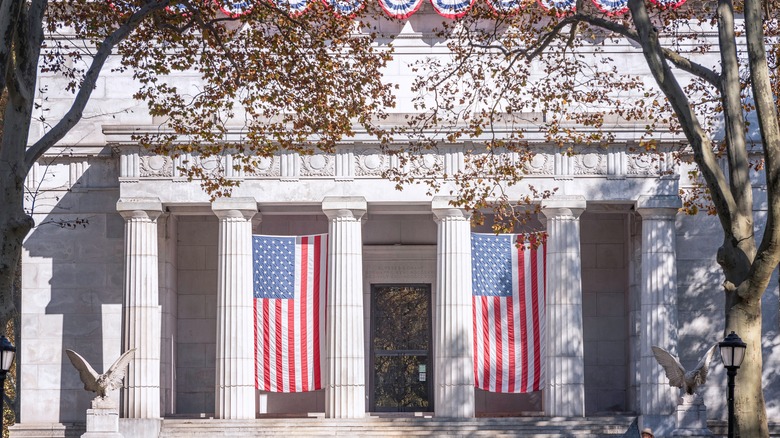North America's Largest Mausoleum Is A Historic Architectural Haven In New York
There is no end to the thrilling diversions you'll find amidst the dazzling lights of the Big Apple. Hopeless romantics can enjoy a stroll along this scenic riverfront park with skyline views. If you're a gourmand, then don't miss this chic steakhouse serving top-notch Kobe beef. And if you enjoy breathtaking architecture and historic sites, then consider a visit to this underrated landmark tucked opposite Riverside Church and Sakura Park in Morningside Heights, just beyond the Upper West Side. Known as the General Grant National Memorial, this domed mausoleum is the final resting place of Ulysses S. Grant, the Civil War general, and later president, who brought an end to a devastating chapter in American history.
Sometimes called Grant's Tomb, the impressive dome supported by a ring of ionic columns rises to 150 feet, making it the largest mausoleum in North America. Construction was funded by a grassroots effort of more than 90,000 people, and today the glistening marble and granite tomb is a shining tribute to one of America's great war heroes. When the mausoleum was unveiled in 1897, an estimated 1 million people gathered in the streets for the dedication ceremony, a testament to their gratitude for the president who worked to rebuild the nation after the ravages of civil war.
The tomb's architect, John Duncan, submitted sketches as part of a competition held by the Grant Monument Association, which were eventually chosen as the winner. Duncan proposed a tomb design inspired by the classical buildings in Europe, which is reflected majestically throughout the mausoleum, from the colonnaded entrance steps to the conical dome. Grant's presidential campaign slogan, "Let us have peace," is inscribed in relief on the mausoleum's lintel and flanked by Roman allegories of victory and peace, a poignant reminder for all visitors.
Explore General Grant's mausoleum and nearby attractions
The nearest subway station to the General Grant National Memorial is Cathedral Parkway (110th Street), and from there it's a roughly 20-minute walk. A short, paved avenue lined with trees leads to the steps of the memorial. As you head inside the mausoleum, you'll be met with the mesmerizing sight of coffered ceilings in swooping arches, ornate pendentives, and, in the center, the crypt with two granite sarcophagi where Grant and his wife, Julia, are buried. Keep an eye out for the three mosaic lunettes within the details of the domed ceiling, portraying scenes of General Grant during the Civil War.
Head further inside the mausoleum and take the staircase down into the crypt, where fascinating artifacts await. Replica battle flags are displayed here, along with wall maps marking Civil War battlefields. The battles involving General Grant are marked with a red star. Continue downwards to see Grant's immense sarcophagus up close, flanked by bronze busts of his fellow generals, a truly mesmerizing sight.
If you're still in the mood to explore, there are plenty of fascinating landmarks in the area that shouldn't be missed. Sakura Park is a stunning green space for a leisurely wander, only four minutes away on foot. Visit in the spring to see the park's namesake cherry blossom trees in full bloom. A 20-minute walk south along Broadway to West 113th Street will take you to the Cathedral of Saint John the Divine, a magnificent Gothic edifice. Or you could catch a cab for 20 minutes down to the Frick Collection on East 70th Street, an intimate art museum that tourists rate higher than the Met. But whether you're a Civil War buff or simply enjoy classical architecture, a visit to this majestic mausoleum will be unforgettable.

